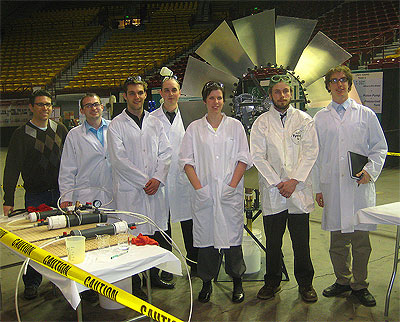 |
| ¬È∂π¥´√Ω professor Graham Gagnon with combined discipline team members, Matthew Follett, Jeffrey Allen, Andrew Hildebrand,¬ÝDannica Switzer, Thomas MacDonald and Daniel Barker, at the WERC competition in New Mexico. |
Here in Halifax, we take it for granted. Turn on the tap and there it is: fresh, clean water ready to drink.
But in many places around the world, people aren’t so lucky. Their water may be brackish, contaminated with arsenic or mercury, or carry diseases.
A group of ¬È∂π¥´√Ω engineering students went to work on the brackish water problem‚Äîwhat could they design to desalinate water to make it drinkable? And just to make it extra difficult, their design had to be fairly simple and low tech, powered by wind and free of electricity.
‚ÄúThe goal was to make a treatment system suitable for rural and/or developing regions,‚Äù says Dannica Switzer, who just graduated from ¬È∂π¥´√Ω with two degrees, engineering and science, and is now working for a geo-technical engineering firm in Victoria, B.C. ‚ÄúSo it had to be fairly robust and easily maintained. It just wouldn‚Äôt work if the system was fancy and high tech.‚Äù
Their solution was a wind-powered water filtration system.
While looking for a senior design project topic last fall, Ms. Switzer and her project partner Matt Follett approached Graham Gagnon, a professor in Civil Engineering and Canada Research Chair in Water Quality and Treatment. He told the students about an international design contest held annually by WERC, a consortium for environmental education and technology development, at New Mexico State University in Las Cruces, New Mexico. One of the tasks for the 2009 contest was Wind-2-H2O: Converting Wind Energy to Mechanical Energy for Water Treatment.
Collaboration across disciplines
The students were interested, but it seemed the mechanics of the project put it outside their expertise, as both were studying civil engineering. Coincidentally, a group of mechanical engineering students were looking for a senior design project too—“They were talking about things like ‘gear ratio’ and ‘start-up torque,’ and, we were like, hang on, we’ve got something for you,” laughs Ms. Switzer, 24. The two groups joined forces and submitted their joint project for the competition at the end of the academic year.
Under the supervision of Prof. Alex Kalamkarov, the mechanical engineering students—Jeffrey Allen, Andrew Hildebrand, Daniel Barker and Tom MacDonald—took over the design of the windmill part of the project, while the two civil engineering students went to work on the water filtration portion.
The final design consisted of a multi-bladed wind turbine that powered a piston pump and delivered pressurized water to the water treatment processes. Those treatments were comprised of ion-exchange resins, pH-adjustment (by having the water pass over crushed oyster shells) and then “polishing,” which included reverse osmosis and nano-filtration membranes.
“It was a lot of lab work; it was very intense for the both of us,” says Ms. Switzer, of the time she and Mr. Follett spent in the water lab working on their project. “We were in the lab about 30 hours a week.”
But the project—the culmination of several intense months of design, prototype building, testing and learning about each other’s disciplines—was worth it for the six senior students. Winning at the WERC design competition was the icing on top.
Sole Canadian team
The¬Ýteam tied for second place out of 10 university teams participating in the Wind-2-H2O task at the WERC design competition in New Mexico in early April. The Dal team‚Äîthe only one from a Canadian university‚Äîwas also presented with the ‚Äúbest conversion of wind energy to mechanical energy‚Äù award, which Ms. Switzer translates enthusiastically as ‚Äúthe most awesome windmill‚Äù prize.
“We were really excited about this project,” she says. “We felt it was worthwhile and that it had real world utility.”
One of the most interesting aspects of the competition was seeing what the other teams came up with using the same parameters (low tech, no electricity). Many of the teams, especially those from dry, balmy climates, used solar distillation, which the Dal team, coming from cold, rainy Halifax, never even considered. “It was neat to see how regional geography affected teams’ design decisions.”
